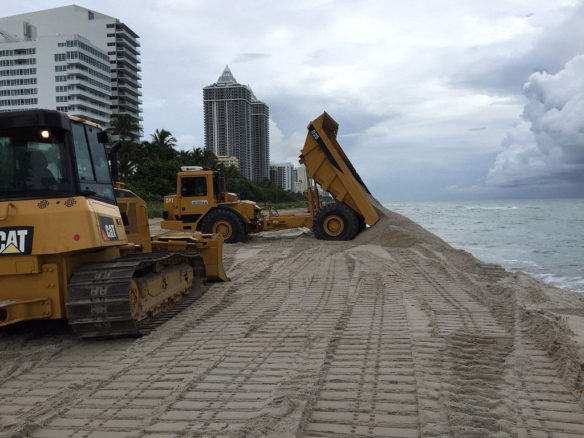
Miami beach renourishment, Florida, 8-30-2016. Photo source: ©© Jaxstrong
“Development is absolutely responsible for the majority of the beach nourishment,” Andrew Coburn, assistant director of The Program for the Study of Developed Shorelines at Western Carolina University, said. “Well over 99 percent of the shorelines that are nourished are developed so there is some economic value placed behind them.”
Excerpts;
To widen a 3,000-foot stretch of Miami Beach’s shore that was washing away, the U.S. Army Corps of Engineers dumped 285,412 tons of sand on Mid-Beach.
The $11.5 million project, funded with a combination of federal, state and county dollars, expanded the shore at 46th and 54th streets by about 230 feet…
Read Full Article; Miami Herald (03-28-2017)
Sand’s end, The Verge (11-17-2016)
Miami Beach has run out of sand. Now what?..
Can Miami Beach Hold Its Ground Against King Tides? NRDC (10-27-2016)
Shrinking Shores: Florida reneges on pledges to its beaches; The Naples Daily News (11-17-2016)
The shores shrink, the tourists scatter, the tax base shrivels. That’s what troubles many communities across the state forced to shoulder the expensive burden of beach renourishment…
Developers don’t get it: climate change means we need to retreat from the coast, Guardian UK (15-03-2016)
It is preposterous to build in areas that are bound to flood. So why are real estate companies still doing it?..
Miami Beach Sees Rising Seas as No Threat to Real Estate Boom, For Now; Phys.Org (04-22-2015)
Increased flooding, accelerated sea-level rise in Miami over last decade, new study shows; Science Daily (04-05-2016)
Miami Beach flood events have significantly increased over the last decade due to an acceleration of sea-level rise in South Florida, a new report warns. The researchers suggest that regional sea-level projections should be used in place of global projections to better prepare for future flood hazards in the region…
Us Warned: “Hands Off Our Beaches!”; Tribune 242 (01-04-2017)
The US is looking at Bahamian sand as a resource to shore-up Florida’s eroding coastline.
Atlantic City and Miami Beach: two takes on tackling the rising waters; Guardian UK (03-20-2017)
Coastal geologist criticizes beach renourishment efforts; By Robert S. Young, PhD; The State (08-17-2016)
Rob Young, who heads the Program for the Study of Developed Shorelines at Western Carolina University, said the government is subsidizing coastal development with renourishment money – and that’s costing taxpayers. Communities across the country have spent millions of dollars renourishing beaches. Those efforts encourage people to rebuild after every major hurricane…
Is Beach Renourishment Worth The Money? WWAY News (02-16-2015)
Waikiki Beach Eroding Less Than A Year After $2.2M Sand Restoration, Pacific Business News (Uploaded 01-24-2013)
A section of Hawaii’s famed Waikiki Beach is starting to erode, less than a year after the completion of a $2.2 million project to replenish the sand on about 1,730 feet of shoreline that had been suffering from chronic erosion.
Beach replenishment may have far reaching impacts on ecosystems;” Phys.Org (03-29-2016)
UC San Diego biologists who examined the biological impact of replenishing eroded beaches with offshore sand found that such beach replenishment efforts could have long-term negative impacts on coastal ecosystems…
Economy Winner, Environment Loser in Renourishment; Pensacola News Journal (12-02-2015)
Palm Beach Mid-Town Dredge Project, A Youtube Video (02-04-2015)
“Beach nourishment projects like this have become commonplace along the US East and Gulf Coasts. These projects have immediate environmental impacts through burial of nearshore habitat and increased turbidity during project placement.The cumulative environmental impacts of doing this repeatedly on the same beach while conducting projects from Maine to Texas is unknown. But, we should be concerned. ” —Robert S. Young, PhD, Director, Program for the Study of Developed Shorelines, Professor, Coastal Geology, Western Carolina University
Living shorelines a more natural approach to preventing coastal erosion; (05-18-2016)
For centuries, large bulkheads have been used to help control erosion along coastlines. More recent research suggests that a natural approach may be a better alternative. Having nature on your side, especially during a storm or hurricane, is proven to provide better protection from coastal erosion…
Rethinking Living Shorelines, By Orrin H. Pilkey, Rob Young, Norma Longo, and Andy Coburn;Program for the Study of Developed Shorelines / Western Carolina University, March 1, 2012, Nicholas School of the Environment, Duke University
In response to the detrimental environmental impacts caused by traditional erosion control structures, environmental groups, state and federal resource management agencies, now advocate an approach known as “Living Shorelines”that embraces the use of natural habitat elements such as indigenous vegetation, to stabilize and protect eroding shorelines.
“Retreat from a Rising Sea: Hard Choices in an Age of Climate Change,” A book by Orrin H. Pilkey, Linda Pilkey-Jarvis, and Keith C. Pilkey
“Retreat from a Rising Sea: Hard Choices in an Age of Climate Change” is a big-picture, policy-oriented book that explains in gripping terms, what rising oceans will do to coastal cities and the drastic actions we must take now to remove vulnerable populations.
Sand Wars, An Investigation Documentary, By Mutlti-Awards Winner Filmmaker Denis Delestrac (©-2013)
Sand is the second most consumed natural resource, after water. The construction-building industry is by far the largest consumer of this finite resource. Land reclamation, shoreline developments and road embankments are using massive amounts of sand as well.
As of 2011-2012, when investigative filmmaker Denis Delestrac and team, were first collecting and unveiling unpublished sand mining datas and information from the professionals involved, the Sand business was estimated to be a $70 billion industry, worldwide…!—Denis Delestrac (©-2013)









